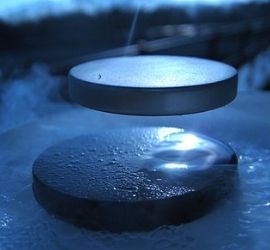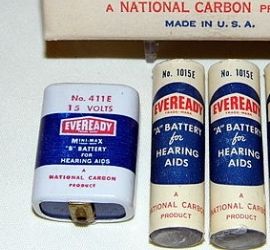What is Superconductivity?

Superconductivity is a state where electrical resistance completely disappears in various solids cooled below their transition temperature. In a superconductive condition, a charge moves through a material without resistance. Theoretically, this allows electrical energy to be transferred between two points with perfect efficiency, losing nothing to heat.
In a Superconductive state, there is a complete disappearance of electrical resistance. This can occur in various solids when they are cooled below a characteristic temperature. This temperature is called the transition temperature. It varies for different materials but generally is below 20 Kelvin or −253 °C. Below this critical temperature, materials undergo a transition into the superconducting state. It is characterized by two basic properties.
- No resistance – They offer no resistance to the passage of electrical current. When resistance falls to zero, a current can circulate inside the material without any dissipation of energy.
- Magnetic fields don’t penetrate – Provided they are sufficiently weak, external magnetic fields will not penetrate the superconductor. Instead, they will remain at the surface. This field expulsion phenomenon is known as the Meissner effect. It is named after the physicist who first observed it in 1933.
Why is Superconductivity Important?
In an ideal world, we would already have superconducting materials wired into our electronics and power grids. This would save huge amounts of energy and allow us to cram even more electronic circuits into confined spaces. Unfortunately, there’s a catch. Most superconducting materials only display this property at temperatures of just above absolute zero. At this temperature, atoms barely move. If a room-temperature superconductor could be used at atmospheric pressure, it could save vast amounts of energy lost to resistance in the electrical grid. And it could improve current technologies, from MRI machines to quantum computers to magnetically levitated trains.
Suggested Uses
Suggested uses for superconducting materials include medical magnetic-imaging devices, magnetic energy-storage systems, motors, generators, transformers, computer parts, and very sensitive devices for measuring magnetic fields, voltages, or currents. The main advantages of devices made from superconductors are low power dissipation, high-speed operation, and high sensitivity. (Source: britannica.com)
How Does Superconductivity Work?
Super-cooled superconductors typically work by allowing electrons to overcome their usual repulsion to each other. As a result, they can move closer together to form what is known as Cooper pairs. In this low energy state, the identity of each individual electron becomes less certain. This allows them to slip through the crowd of atoms with greater ease. While most superconducting materials are metals, there are unusual exceptions. Some require extra elements to be added and work in subtly different ways that defy existing theories.
Initial discovery
In 1911, while studying the properties of matter at very low temperatures, the Dutch physicist Heike Kamerlingh Onnes and his team discovered that the electrical resistance of mercury goes to zero below 4.2 K (-269°C). This was the very first observation of the phenomenon of superconductivity. The majority of chemical elements become superconducting at sufficiently low temperatures. (Source: home.cern)
Superconductivity Facts
- Superconductivity was discovered in 1911 by Heike Kamerlingh-Onnes. For this discovery, the liquefaction of helium, and other achievements, he won the 1913 Nobel Prize in Physics.
- Five Nobel Prizes in Physics have been awarded for research in superconductivity (1913, 1972, 1973, 1987, and 2003).
- Approximately half of the elements in the periodic table display low-temperature superconductivity, but applications of superconductivity often employ easier to use or less expensive alloys. For example, MRI machines use an alloy of niobium and titanium. (Source: energy.gov)
Thermal Properties Of Superconductors
Superconductivity is a startling departure from the properties of normal, nonsuperconductors of electricity. In normal materials that conduct electricity, some of the electrons are not bound to individual atoms. As a result, they are free to move through the material. Their motion results in an electric current. In normal conductors, these so-called conduction electrons are scattered by impurities, dislocations, grain boundaries, and lattice vibrations. In a superconductor, however, there is an ordering among the conduction electrons that prevents this scattering. Consequently, electric current can flow with no resistance at all. The ordering of the electrons is called Cooper pairing. It involves the mass and velocity of the electrons rather than their positions.
The energy per electron that is associated with this ordering is extremely small. It is typically about one-thousandth of the amount per electron compared to when a chemical reaction takes place. One reason that superconductivity remained unexplained for so long is the smallness of the energy changes that accompany the transition between normal and superconducting states. In fact, many incorrect theories of superconductivity were advanced before the BCS theory was proposed. (Source: britannica.com)
Room-temperature Superconductivity
In recent years, researchers have been making great strides. Now, they are pushing the temperature limits on how cold a superconducting material needs to be to function. The current record holder is a compound made of sulfur and hydrogen. This compound can superconduct electricity at a relatively warm 203 Kelvin (-70 degrees Celsius or -94 Fahrenheit). However, the only catch is it requires pressures of 1.5 million atmospheres to form. Eventually, as physicists learn more about superconducting materials they will develop more accurate models of the phenomenon. Perhaps they may eventually bring us closer to superconductors that can operate comfortably in your pocket. (Source: sciencealert.com)
The Future of Superconductivity
There is a lot we don’t know about superconductive materials. Regardless, we are developing new applications for superconductors every day. Some day, the hope is to one-day use superconductivity in power transmissions. This would dramatically reduce energy costs around the world. Mag-lev trains use superconductivity to hover a train car above the rail. Completely eliminating friction that might slow a train down may ultimately be the future of transportation.
Maybe, one day we’ll have electronics that utilize superconductors. It could yield smartphone batteries that only need to be charged once a month or more. It’s anyone’s guess, but with the rapid advances in our technology, we’ll all likely see superconductivity in our lives as a regular feature sooner rather than later. (Source: interestingengineering.com)
Up Next: Solar Minimum – Is a Mini Ice-Age Coming?
 A solar minimum is a reduced period of sunspot activity in the solar cycle. Some warn of a possible mini ice-age. However, scientists say it’s just business as usual.
A solar minimum is a reduced period of sunspot activity in the solar cycle. Some warn of a possible mini ice-age. However, scientists say it’s just business as usual.
We are normal people living in normal times. Therefore, you can expect normal things to happen. There are news tabloids reporting that a sun lockdown period is occurring. Or, that Earth is doomed from crazy weather, famine, and even earthquakes for some reason. At this point, anyway, you can relax. Nothing the Sun is currently doing is going to create a mini ice-age, famine, or earthquakes. As a matter of fact, the Sun is doing nothing unusual whatsoever. What is happening is a very normal period in the Sun’s 11-year cycle, and it’s called a solar minimum. Moreover, it’s nothing to be afraid of. Chances are you’ve already lived through several solar minimums without even noticing.


